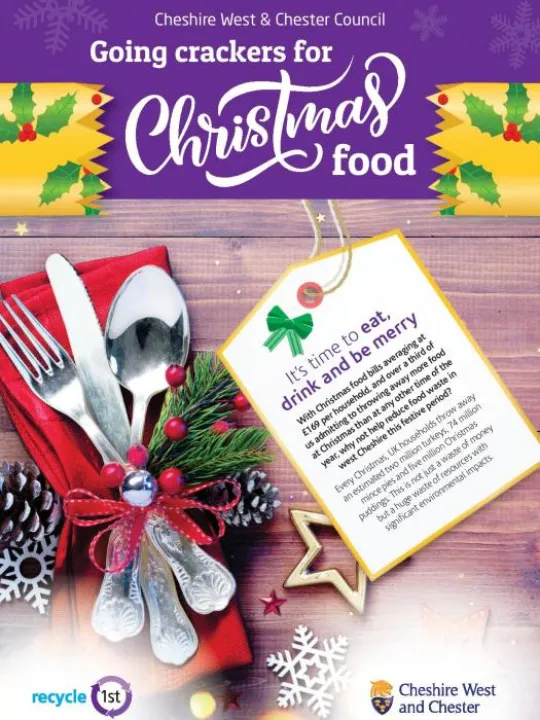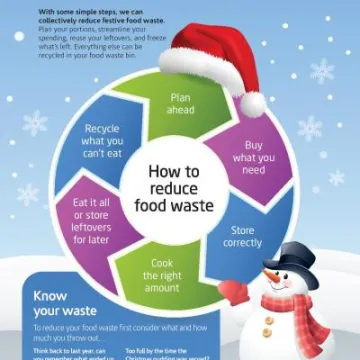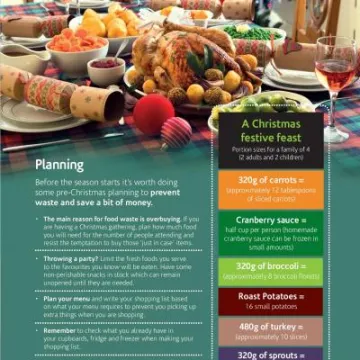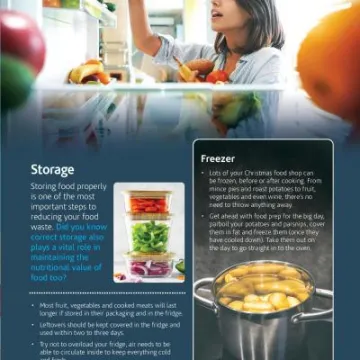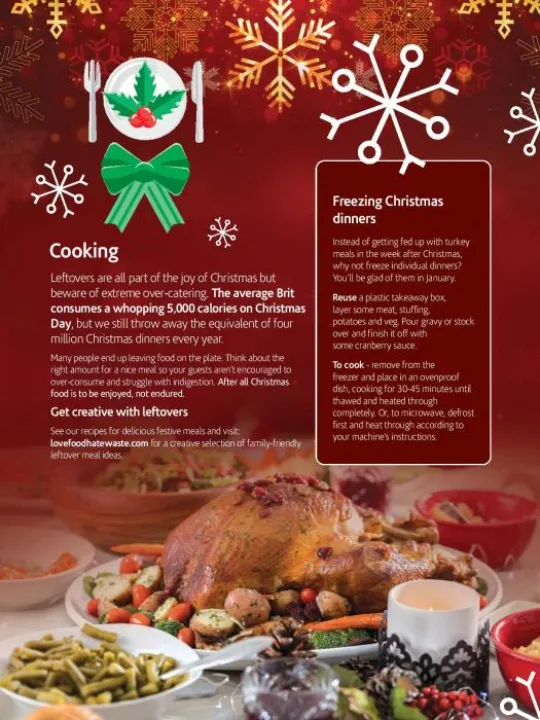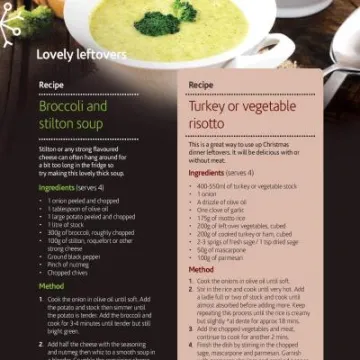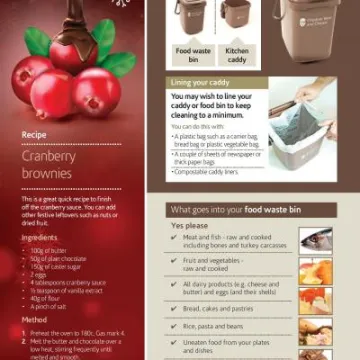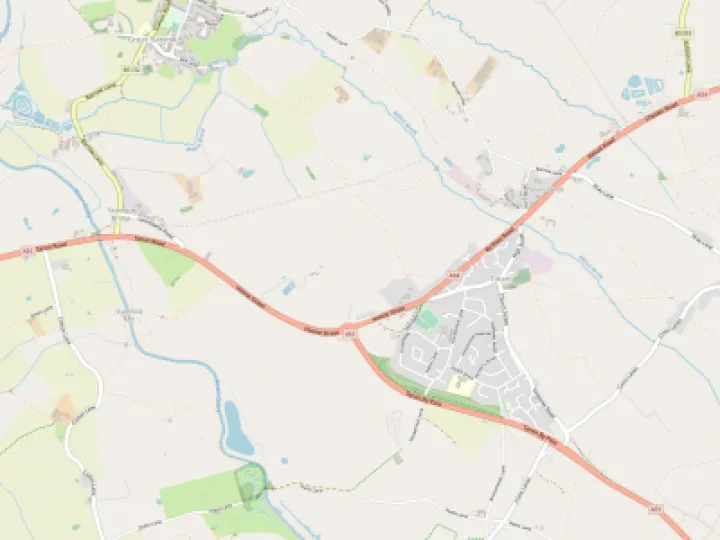Christmas Food – Waste Avoidance
Food waste is a bigger problem than many people realize.
In fact, nearly one-third of all food produced in the world is discarded or wasted for various reasons. That equates to nearly 1.3 billion tons every year.
While you might not think food waste affects you, think again.
Tossing edible food doesn't just waste money. Discarded food is sent to landfills, where it rots and produces methane gas, which is the second most common greenhouse gas. In other words, throwing out your food contributes to climate change.
It wastes a huge amount of water, too. According to the World Resources Institute, 24% of all the water used for agriculture is lost through food waste every year. That's 45 trillion gallons (about 170 trillion litres).
Although these numbers may seem overwhelming, you can help reduce this harmful practice by following these easy tips. Every little bit helps.
1. Shop Smart
Most people tend to buy more food than they need.
- Though buying in bulk may be convenient, research has shown that this shopping method leads to more food waste.
- To avoid buying more food than you need, make frequent trips to the grocery shop every few days rather than doing a bulk shopping trip once a week.
- Make a point to use up all the food you purchased during the last trip to the market before buying more groceries.
- Additionally, try making a list of items that you need to buy and stick to that list. This will help you reduce impulse buying and reduce food waste as well.
2. Store Food Correctly
Improper storage leads to a massive amount of food waste.
About two-thirds of household waste in the United Kingdom is due to food spoilage.
Many people are unsure how to store fruits and vegetables, which can lead to premature ripening and, eventually, rotten produce.
For instance, potatoes, tomatoes, garlic, cucumbers and onions should never be refrigerated. These items should be kept at room temperature.
Separating foods that produce more ethylene gas from those that don't is another great way to reduce food spoilage. Ethylene promotes ripening in foods and could lead to spoilage.
Foods that produce ethylene gas while ripening include:
- Bananas
- Avocados
- Tomatoes
- Cantaloupes
- Peaches
- Pears
- Green onions
Keep these foods away from ethylene-sensitive produce like potatoes, apples, leafy greens, berries and peppers to avoid premature spoilage.
3. Learn to Preserve
While you might think fermenting and pickling are new fads, food preservation techniques like these have been used for thousands of years.
Pickling, a type of preservation method using brine or vinegar, may have been used as far back as 2400 BC (5).
Pickling, drying, canning, fermenting, freezing and curing are all methods you can use to make food last longer, thus reducing waste.
Not only will these methods shrink your carbon footprint, they will save you money as well. What's more, most preservation techniques are simple and can be fun.
For example, canning an excess of ripe apples and turning them into applesauce, or pickling fresh carrots from the market will provide you with a delicious and long-lasting treat that even kids will enjoy.
4. Don't Be a Perfectionist
Did you know that rummaging through a box of apples until you find the most perfect-looking one contributes to food waste?
Though identical in taste and nutrition, so-called "ugly" fruits and vegetables get passed up for produce that is more pleasing to the eye.
The consumer demand for flawless fruits and vegetables has led major grocery chains to buy only picture-perfect produce from farmers. This leads to tons of perfectly good food going to waste.
It's such a big issue that major grocery chains have started offering "ugly" fruits and vegetables at a discount in an attempt to reduce waste.
Do your part by choosing slightly imperfect produce at the shop, or better yet, directly from the farmer.
5. Keep Your Fridge Clutter-Free
You've probably heard the saying, "out of sight, out of mind." This rings especially true when it comes to food.
While having a well-stocked fridge can be a good thing, an overly filled fridge can be bad when it comes to food waste.
Help avoid food spoilage by keeping your fridge organized so you can clearly see foods and know when they were purchased.
A good way to stock your fridge is by using the FIFO method, which stands for "first in, first out."
For example, when you buy a new bottle of milk, place the newer bottle behind the old one. This helps ensure that older food gets used, not wasted.
6. Save Leftovers
Leftovers aren't just for holidays.
Although many people save excess food from large meals, it is often forgotten in the fridge, then tossed when it goes bad.
Storing leftovers in a clear glass container, rather than in an opaque container, helps ensure you don't forget the food.
If you happen to cook a lot and you regularly have leftovers, designate a day to use up any that have accumulated in the fridge. It's a great way to avoid throwing away food.
What's more, it saves you time and money.
7. Eat the Skin
People often remove the skins of fruits, veggies and chicken when preparing meals.
This is a shame, because so many nutrients are located in the outer layer of produce and in poultry skin. For example, apple skins contain a large amount of fibre, vitamins, minerals and antioxidants.
In fact, researchers have identified a group of compounds present in apple peels called triterpenoids. They act as potent antioxidants in the body and may have cancer-fighting abilities.
Chicken skin is packed with nutrients as well, including vitamin A, B vitamins, protein and healthy fats. What's more, chicken skin is an amazing source of the antioxidant selenium, which helps combat inflammation in the body.
These benefits are not limited to chicken and apple skin. The outer layers of potatoes, carrots, cucumbers, mangoes, kiwis and aubergines are also edible and nutritious.
Not only is eating the skin delicious, it's economical and reduces your food waste impact.
8. Eat the Yolk
Although most people are moving away from the once-popular low-fat dieting trend, many still avoid egg yolks, opting for egg-white omelets and scrambled egg whites instead.
Avoiding egg yolks mostly stems from the fear that they increase cholesterol levels. Many people assume that eating foods high in cholesterol, like eggs, has a major impact on cholesterol levels. Your liver actually makes the majority of the cholesterol you need and your body closely regulates levels in the blood. When you eat foods that contain a high amount of cholesterol, your liver simply compensates by producing less.
In fact, evidence shows that most people, even those with high cholesterol, can enjoy whole eggs risk-free. What's more, egg yolks are packed with nutrients, including protein, vitamin A, iron, selenium and B vitamins (13).
If you simply don't like the taste or texture of egg yolks, you can add them to other recipes to mask the flavor. You can even use yolks as an ultra-moisturizing hair mask.
9. Be a Seed Saver
Aside from using the tasty flesh of your pumpkins in recipes and baking, a great way to cut waste is to save the seeds. In fact, pumpkin seeds are tasty and packed with nutrients. They are very high in magnesium, a mineral that is important for heart and blood health and helps control blood pressure and blood sugar levels.
To save pumpkin seeds, simply wash and dry the seeds, then toss them with a little olive oil and salt and toast them in the oven.
Acorn and butternut squash seeds can be prepared in the same way.
10. Blend it up
Blending up a nutrient-packed smoothie can be a delicious way to reduce food waste.
While the stems, ends and peels of produce may not be appetizing in their whole form, adding them to a smoothie is a way to reap their many benefits.
The stems of greens like kale and chard are packed with fibre and nutrients, making them a great addition to smoothies. The tops of beets, strawberries and carrots also make great add-ins.
Other items that would otherwise be discarded can also be thrown into a nutritious blend, including fruit and vegetable peels, wilted herbs, overripe bananas and chopped broccoli stalks.
11. Make Homemade Stock
Whipping up a homemade stock is an easy way to use excess food.
Sauté vegetable scraps like the tops, stalks, peels and any other leftover bits with some olive oil or butter, then add water and let them simmer into an aromatic vegetable broth. Veggies aren't the only scraps that can be transformed into a flavorsome stock.
Rather than letting the chicken carcass or meat bones leftover from your dinner go to waste, simmer them with veggies, herbs and water to make a homemade stock that will put store-bought broth to shame.
12. Perk Up Your Water
Many people don't drink enough water simply because they don't like the flavor, or lack thereof.
Luckily, you can make water tastier and reduce your food waste impact at the same time.
One of the easiest ways to increase your water intake is to make it taste good. Use peels from citrus fruits, apples and cucumbers to add a kick to your glass of water.
Wilted herbs and berry tops also make excellent additions to your water bottle.
After finishing your water, toss the leftover fruit or herbs into a smoothie for a zero-waste nutrition boost.
13. Keep Your Serving Sizes in Check
Overeating is a problem for many people.
Making sure your portion sizes stay within a healthy range doesn't just help keep your weight down, it also reduces food waste.
While you may not think twice about scraping the leftover food on your plate into the trash, remember that food waste has a major impact on the environment.
Being more mindful of how hungry you actually are and practicing portion control are great ways to reduce food waste.
14. Get Friendly With Your Freezer
Freezing food is one of the easiest ways to preserve it, and the types of food that take well to freezing are endless.
For example, greens that are a bit too soft to be used in your favorite salad can be put in freezer-safe bags or containers and used at a later date in smoothies and other recipes.
An excess of herbs can be combined with olive oil and chopped garlic, then frozen in ice cube trays for a handy and delicious addition to sautés and other dishes.
You can freeze leftovers from meals, excess produce from your favorite farm shop, and bulk meals like soups and chillis. It's a great way to ensure you always have a healthy, home-cooked meal available.
15. Understand Expiration Dates
"Sell by" and "expires on" are just two of the many confusing terms companies use on food labels to let consumers know when a product will most likely go bad.
In fact, the task is often left to food producers to determine the date they think a product is most likely to spoil by. The truth is, most food that has just passed its expiration date is still safe to eat.
"Sell by" is used to inform retailers when the product should be sold or removed from the shelves. "Best by" is a suggested date that consumers should use their products by.
Neither of these terms means that the product is unsafe to eat after the given date.
While many of these labels are ambiguous, "use by" is the best one to follow. This term means that the food may not be at its best quality past the listed date (17).
A movement is now underway to make the food expiration labeling system more clear for consumers. In the meantime, use your best judgment when deciding whether food that is slightly past its expiration date is safe to eat.
16. Compost If You Can
Composting leftover food is a beneficial way to reuse food scraps, turning food waste into energy for plants.
While not everyone has room for an outdoor composting system, there's a wide range of countertop composting systems that make this practice easy and accessible for everyone, even those with limited space.
An outdoor composter may work well for someone with a large garden, while a countertop composter is best for city dwellers with houseplants or small herb gardens.
17. Pack Your Lunch
Although going out to lunch with co-workers or grabbing a meal from your favorite restaurant may be enjoyable, it is also costly and can contribute to food waste.
A helpful way to save money while reducing your carbon footprint is to bring your lunch to work with you.
If you tend to generate leftovers from home-cooked meals, pack them up for a satisfying and healthy lunch for your workday.
If you're strapped for time in the morning, try freezing your leftovers in portion-sized containers. That way, you'll have pre-made, hearty lunches ready to go each morning.
18. Don't Toss the Grounds
If you can't fathom getting ready for your day without a hot cup of coffee, chances are you generate a lot of coffee grounds.
Interestingly, this often-overlooked leftover has many uses.
Those with a green thumb may be delighted to know that coffee grounds make excellent fertilizer for plants. The grounds are high in nitrogen, phosphorus and potassium, which are nutrients that plants crave.
19. Get Creative in the Kitchen
One of the great things about cooking your own food is that you can tweak recipes to your liking, adding new flavors and ingredients.
Including parts of foods that aren't usually used is an excellent way to re-purpose scraps when you're experimenting in the kitchen.
Stems and stalks make tasty additions to sautés and baked dishes, while garlic and onion ends can bring flavor to stocks and sauces.
Whipping up a fresh pesto made with broccoli stalks, soft tomatoes, or wilted spinach rather than the traditional basil is an inventive way to add a tasty twist to favorite dishes.
20. Pamper Yourself
If you want to save money while avoiding potentially harmful chemicals found in some skincare products, try preparing a scrub or mask at home.
Avocados are packed with healthy fats, antioxidants and vitamin E, which makes them a perfect addition to a natural face mask.
Combine overripe avocado with a bit of honey for a luxurious combination that can be used on the face or hair.
Mixing used coffee grounds with a bit of sugar and olive oil makes for an invigorating body scrub. You can also apply cool used tea bags or excess cucumber slices to your eyes to reduce puffiness.
The Bottom Line
There are endless ways you can reduce, reuse and recycle your food waste.
Not only will these practical tips help you waste less food, they may save you money and time as well.
By thinking more about the food your household wastes every day, you can help create positive change to conserve some of the earth's most valuable resources.
Even minimal changes to the way you shop, cook and consume food will help reduce your impact on the environment. It doesn't have to be difficult.
With a small amount of effort, you can cut your food waste dramatically, save money and time, and help take some pressure off Mother Nature.
Quick Links
Get In Touch
TarvinOnline is powered by our active community.
Please send us your news and views.







